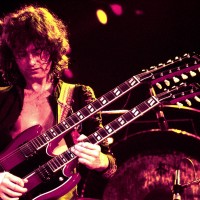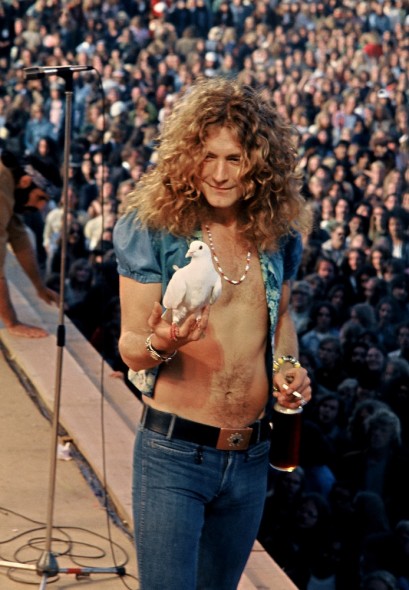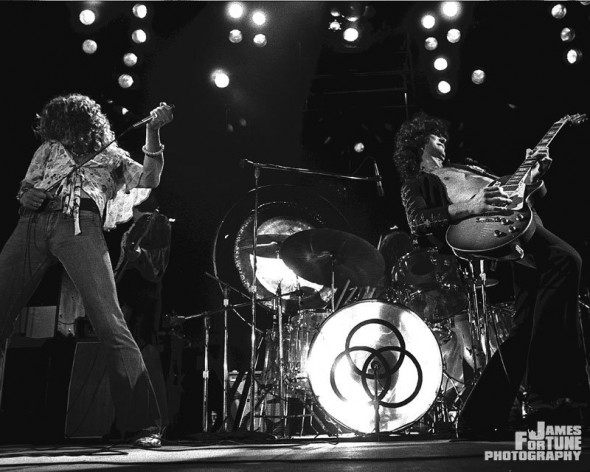40 Years Ago Today
It was 40 years ago today, November 8, 1971, that Led Zeppelin released their long-awaited followup to Led Zeppelin III, the appropriately named Led Zeppelin IV (It wasn’t until 1973’s Houses of the Holy that they actually named the albums). It featured “Black Dog”, “Rock and Roll”, “The Battle of Evermore”, “Stairway to Heaven”, “Misty Mountain Hop”, “Four Sticks”, “Going to California”, and “When the Levee Breaks”. The recording sessions also produced “Down By the Seaside”, “Night Flight”, and “Boogie With Stu”, but they didn’t make the album.
The decision to not name the album was a conscious one. They didn’t want to trade on the “commercial entity” that had become Led Zeppelin. Even the image on the outer sleeve was a commentary on commercialism: An old man and a city in decay. It was, according to Page, “a way of saying that we should look after the earth, not rape and pillage it.” While it peaked at #2 on the U.S. charts, it became the biggest and most durable seller in their catalog. 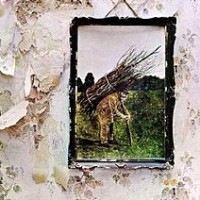
I was able to meet and work with Led Zeppelin many times during their career and this period was particularly exciting and fruitful. I can remember them doing a stretch at The Forum in Inglewood, California. I shot many concerts at the Forum, but shooting Led Zeppelin’s were like working in a room full of static electricity: hair constantly standing straight up. They sold out both nights at The Forum in about 3 1/2 hours. Keep in mind, this was before the Internet and smart phones!
Call it Led Zeppelin IV, or The Fourth, or The Four Symbols, or The Hermit. The name doesn’t really matter. It was and is Rock and Roll, and I call it one of the best albums ever created.
It Was Never Quiet at the Riot Hyatt
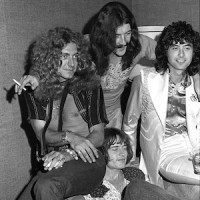 I got a phone call on a quiet Monday in February of 1973 from Led Zeppelin’s publicist. I had been working the rounds in Los Angeles and between the PR guys and record companies I had made a few good contacts. I had run into the publicist for Led Zeppelin a few weeks earlier and asked if I could have some time with the band the next time that they were in town.
I got a phone call on a quiet Monday in February of 1973 from Led Zeppelin’s publicist. I had been working the rounds in Los Angeles and between the PR guys and record companies I had made a few good contacts. I had run into the publicist for Led Zeppelin a few weeks earlier and asked if I could have some time with the band the next time that they were in town.
The band had just come from a tour of England and was taking a month to relax before starting a big U.S. tour. They had four eponymous albums on the charts and were waiting for the release of number 5, Houses of the Holy. The album had hits in No Quarter and The Song Remains the Same. While it departed from much of their blues influences it had funky tracks in The Ocean and D’yer Mak’er. It also had a beautiful acoustic based track, The Rain Song. Much of the initial buzz, however, was about the risqué cover featuring young, naked children.
The call from Zeppelin’s people invited me to meet them at The Continental Hyatt House on the Sunset Strip. The Continental Hyatt had become a base of operations for many up and coming bands as it was close to the Whiskey-A-Go-Go and the many clubs and recording studios in West Hollywood. After spending a few evenings with bands at the Hyatt my friends and I began calling it The Continental Riot House. Led Zeppelin did much to bring about this nickname.
The lads of Zeppelin would typically rent out several entire floors for their antics. Keith Richards became famous for throwing a television out of one of the windows. Keith Moon threw a larger one out of one of the windows. Never one to be outdone, John Bonham liked to unwind with a ride on a Harley Davidson…down the hallways between the suites. Orgies with Jimmy Page, groupies chasing Robert Plant, John Paul Jones’ reserved debauchery, to Bonham being Bonzo; if you’ve read it it’s probably true.
I had hoped to catch the band for dinner and establish a rapport but when I arrived at 6:30 the night’s revelries were obviously well under way. I followed a hotel bartender with a crate of liquor and found a mostly incoherent Robert Plant holding court. I started talking to him about my ideas for some shots but found myself getting nowhere so after a half hour or so I grabbed a drink myself.
I had just about given up on an organized shoot when Peter Grant lumbered in. At 6 foot 5 and well over 350 pounds, I knew Grant’s reputation for getting things done and enlisted his help in making photography happen. 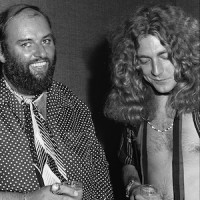
Any pictures of the band that I had seen up until this point had either been stage shots or big horizontal panoramas and I began looking for props to create something different. I found an ugly orange armchair in one of the rooms and asked Grant to help me round up the lads. My idea was a vertical grouping of the band. Newspapers and magazines would love it for the ease of a print layout and it was different than all of the other photos that I’d seen.
Plant and Page arrived and mulled participation. Jones was in another mood and Grant physically put him in place for me. Page and Plant began laughing and plopped down on either arm of the chair. Seeming to sense that he was being left out, Bonham wandered in, smoking a cigarette, and threw his arms around them.
I began furiously working my two cameras, an old favorite loaded with color and my newer Nikon with black and white. I managed to get almost 20 shots before the peace dissolved and chaos returned.
A few days later I was able to get my shots to Led Zeppelin’s publicist and they chose one of the black and whites. Through them I was contacted by Grant who made an offer to buy the whole lot of the color shots. He wanted to buy them all but I saved the best one and never showed it to them.
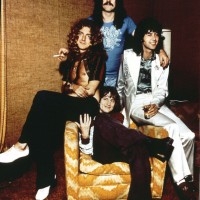 Since that night I’ve gone on to see the black and white in numerous books about Led Zeppelin. It’s been in magazines and even VH1’s Behind the Music. I’ve had a devil of a time tracking down publishers and receiving photographer credits but one thing is for sure. None of those guys ever had an evening like mine with Led Zeppelin at the Continental Riot House.
Since that night I’ve gone on to see the black and white in numerous books about Led Zeppelin. It’s been in magazines and even VH1’s Behind the Music. I’ve had a devil of a time tracking down publishers and receiving photographer credits but one thing is for sure. None of those guys ever had an evening like mine with Led Zeppelin at the Continental Riot House.
Robert Plant With A Dove
The Kezar, San Francisco
| 11×14 Print: | ||
| To License This Image For Use Click Here | ||
Led Zeppelin on Stage
1974 at The Forum, Los Angeles
| 11×14 Print: | ||
| To License This Image For Use Click Here | ||
Jimmy Page on postage stamp
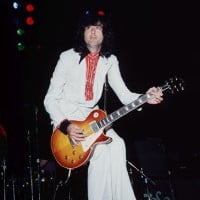 It’s interesting to see Jimmy on a stamp, check the link out below. In the interview, he disses the book by Mick Walls out that enhances and exaggerates the Zeppelin interest in the occult and Aleister Crowley. The truth will never be know, as Jimmy Page shows little interest in revealing anything. He says he gets along fine with Robert Plant, even though Plant does not want to tour. Good article!
It’s interesting to see Jimmy on a stamp, check the link out below. In the interview, he disses the book by Mick Walls out that enhances and exaggerates the Zeppelin interest in the occult and Aleister Crowley. The truth will never be know, as Jimmy Page shows little interest in revealing anything. He says he gets along fine with Robert Plant, even though Plant does not want to tour. Good article!
http://entertainment.timesonline.co.uk/tol/arts_and_entertainment/music/article6979627.ece
John Paul Jones Article- Butthole Surfers?
 This is a great overview of John Paul Jones, bass player for Led Zeppelin till they collapsed. I did not know he produced an album for the Butthole Surfers (a Texas band), that really shows a wide range of taste in music. It mentioned how his career post Zeppelin equals or exceeds Page or Plant in scope and quality. Great photograph of Them Crooked Vultures, a reference to the music industry. Note: Butthole Surfers had an album they called “Sympathy for the Record Industry,” obviously a slur on the Stones song that hits the music biz.
This is a great overview of John Paul Jones, bass player for Led Zeppelin till they collapsed. I did not know he produced an album for the Butthole Surfers (a Texas band), that really shows a wide range of taste in music. It mentioned how his career post Zeppelin equals or exceeds Page or Plant in scope and quality. Great photograph of Them Crooked Vultures, a reference to the music industry. Note: Butthole Surfers had an album they called “Sympathy for the Record Industry,” obviously a slur on the Stones song that hits the music biz.
http://www.guardian.co.uk/music/2009/dec/10/john-paul-jones-them-crooked-vultures
Fame and Fortune: Legendary Photographs
Fame and Fortune: Legendary Photographs by James Fortune of Rock’s Greatest Stars
By Brooke Saunders
In the late sixties and seventies, James Fortune took more than 20,000 pictures of The Doors, Led Zeppelin, Paul McCartney, The Who, The Rolling Stones, Elton John, Bob Dylan, Iggy Pop, and many others, both onstage and off. His work has graced the cover of Jimmy Page’s solo CD “How The West Was Won,” Led Zeppelin’s “Mothership” CD, and a recent Who documentary. Eighteen prints are displayed in the Rock and Roll Hall of Fame, and countless coffee-table books contain his pictures, including the latest one about The Doors.
One of Fortune’s best-known images is Robert Plant holding a dove that had just landed in his hands, framed by a massive crowd at Kezar Stadium in San Francisco. This became one of the most famous rock posters ever, Led Zeppelin was breaking the Beatle’s record for attendance at one concert, and a print now hangs in Plant’s home in England.
Fortune’s career began when he filmed the LA riots on Sunset Boulevard in 1966, and a picture of protesters on the roof of a bus was in publications around the world. But the first rock star shoot was in May 1967, when Fortune contacted record companies from his college newspaper, and gotten results.
“To my surprise, Elektra Records called back asking me if I could photograph one of their new bands, The Doors, at a recording session. When we arrived at Sunset Sound, we found Jim Morrison leaning against a wall staring at us, so we said hello, and entered the studio, and introduced ourselves to Paul Rothchild, their producer. As we sat down in the control room, we heard them playing back the instrumental of “I Can See Your Face In My Mind.”
Later in the session, vocals were added, relates Fortune. “Morrison wanted the lights turned down low as he sang.” The band finished, and Fortune took more pictures outside.
“Rothchild called for a break, and we went out on Sunset Boulevard, and I got a few photos of the band. I also photographed them at the Santa Monica Civic Auditorium, and in the back of a limousine, which is the one of Morrison with a hat pulled down.”
Fortune went into the Navy from 1968 to 1969 as a combat photographer, and after returning, he got a job taking pictures for the National Association for Record Merchandising, the largest of the recording industry trade associations. For the next seven years, he photographed bands at the many events held by N.A.R.M, resulting in many of his best shots.
In 1973, a call came from Led Zeppelin’s publicist, and Fortune was asked to meet the band at the Continental Hyatt House on Sunset Boulevard. They always stayed at the Hyatt, which was jokingly called the “Continental Riot House,” because of all the wild parties. It was a familiar place to Fortune.
“The rumors you hear about Led Zeppelin’s parties there are all true, from Harley rides down hallways to staged drugged-out orgies, not to mention the secret affair between Jimmy Page and his 14-year old model Lori Maddox. Too bad there are not more photos of what went down there.”
When arriving at the suite, the band was too drunk to cooperate with the photo taking. So their large and beefy road manager Peter Grant bodily picked them up, and put them in a chair that would be best for the picture.
“I wanted a close shot that would be good for the newspapers, because there were already a lot of pictures out there with wide angles. The chair in the corner looked good for that purpose.”
In 1974, Fortune teamed up with Bob Yamasaki and One Stop Posters in Los Angeles. Over the next five years, they published ten rock and roll posters that sold over 700,000 copies.
Fortune took pictures of Paul McCartney and his family on several occasions in Los Angeles in 1975, and tells the story.
“I walked into the pool area where McCartney and his family were sitting. Then Paul came out of the pool, and held a white towel against his body in a great imitation of Gypsy Rose Lee, so I snapped a picture. As we hung around the pool, Paul’s little girl climbed out and said, “my feets are hot, my feets are hot.” I set down my camera and carried her over to Paul’s wife, Linda, who thanked me. I finished taking a number of photos there, and then I was asked to come back the next day to the Beverly Hills Hotel, and then again for another visit.”
The former Beatle ordered a half-dozen 11 x 14 prints from the sessions, according to Fortune, and was a pleasure to work with.
Michael O’Sullivan of the Washington Post wrote in 2005 about an exhibition of Fortune’s pictures, calling him a “prolific chronicler of rock royalty.” Some of the pictures he described included Keith Moon “cavorting with what appear to be topless groupies,” and a portrait of a “buff, bleeding, and not-yet-wizened Iggy Pop” after a performance at the Whisky a Go-Go in LA.
In that picture, Iggy was flipping the bird, and this classic takes its place along with rock’s most stunning and violent images, such as Jimi Hendrix setting fire to his guitar at Monterey Pop Festival and The Who smashing amps and drums.
But the prize for strangeness among the images, according to O’Sullivan, “must surely go to the artist’s photograph of odd-threesome Linda Lovelace of “Deep Throat” fame; Moon (yes, him again); and Micky Dolenz of the Monkees. Man, wouldn’t you love to hear the story behind that night?”
In 2008, Peter Skinner of Rangerfinder magazine wrote a feature story on Fortune in their July issue, and stated he was “one of the most important photographers to document the halcyon years of rock.” He went on to say “the connection, the intimacy and rapport that exude from Fortune’s images illustrate the close, even personal relationship and trust between subject and photographer. ”
In addition to invitations to some very exclusive events at galleries and openings involving his work, the job still has its perks. Recently, Fortune received at his home in Virginia a package with prints of an Eric Clapton photograph to sign, and there were Clapton’s signatures. “It was great to see that signature and add mine, and ship them out,” said Fortune.
Led Zeppelin Site Extraordinaire
I really like the effort that is made to put this site together, fascinating archive of history about one of the world’s greatest bands ever.
http://onthisdayinledzeppelinhistory.blogspot.com/2002/10/mighty-atom-smasher-launched.html
Led Zeppelin book – Good Times, Bad Times
Check out this review and glimpse of 16 pictures in the book.
http://www.fastcompany.com/pics/how-led-zeppelin-changed-music-business
Robert Plant- Meeting him in Richmond VA
Ever since I heard those first notes that begin the first Led Zeppelin album, I was hooked. All of the songs were great, but “Your Time is Gonna Come” was the entry port into a world of musical magic. But I’d never seen Zeppelin or Plant in concert.
So many years later in 1988, when I heard Robert Plant was coming to the Richmond Coliseum on July 20, I got a ticket immediately and headed down there on the appointed day. There were some really interesting characters walking up to the building; bikers, metal heads, all kinds of black leather and skulls, this was plainly an event of significance for many groups of people.
Cheap Trick opened, and the crowd really started going. They did a great version of “I Want You To Want Me,” and other tunes, and the audience went wild. But the crowd really wanted Robert, and finally the band walked on to the stage to wild cheers, and many fans were giving the sign of the devil with first and last fingers. I understand this hand gesture was started by Gene Simmons, who was merely holding his pick with his second and third fingers against his palm, but I’m not sure.
Plant strolled into the spotlight with long flowing blond hair, as the other musicians took their places. The guitarist was a slender, waif-like Londoner that looked remarkably like Jimmy Page, by the name of Doug Boyle. I believe Plant started with “Heaven Knows,” this tour was in support of that album, which featured Jimmy Page on guitar on that and another song. The sound was great for the Coliseum, it also helped that it was packed. He played “Kashmir,” and “In The Evening,” and then more tunes from the latest album. It was really spellbinding to see him pace the stage, and deliver great vocals to great songs, one of the best concerts I’ve ever seen.
They were joking from the stage that the band would go to Matt’s British Pub in Shockoe Slip afterward, and I took note of that. But not really caring that much about meeting him or the band, I went over to Penny Lane Pub on 7th Street, in its earlier location. There I saw my friend, Jim Turney, who happened to be at the show also. We sat down and ordered some beers, and began talking.
A few minutes later I heard a stir in the crowded bar, and people looking at the entrance. In a few moments, musicians started to stroll in, and following them was Robert Plant, who is every bit of 6.2. It turned out that the information about Matt’s British Pub was a decoy, they were really going to Penny Lane, who is owned by a fellow Englishman who knew Robert.
I could not resist, so I went over to the bar, and introduced myself, complimenting him on the show. He looked pleased, and smiled. He has the greenest eyes you’ll ever see, impressive eyes, and I don’t ordinarily pay attention to eyes. But that was an overwhelming part of his personage. He immediately said, “Well, I hope everyone did not think I was too mellow,” and I responded, “not to me!” I really thought the quieter parts were some of the best moments of the show, his new material is great. He really liked that, as he probably gets annoyed at endless requests for “Whole Lotta Love,” or “Stairway To Heaven.”
We just chatted a few more minutes, can’t remember the details, but I went over to the guitarist eventually. Doug Boyle was very friendly, and I complimented him on his playing and sound, and asked him what effects he used. He said none, any effects I heard were from the PA. I’ve noticed that a lot, some of the best players don’t use much in the way of effects, yet others are masters at manipulating a huge set of pedals. Everyone is different for sure.
It was a wonderful evening, and made even more special by talking to one of the greatest singers in the world, bar none.

